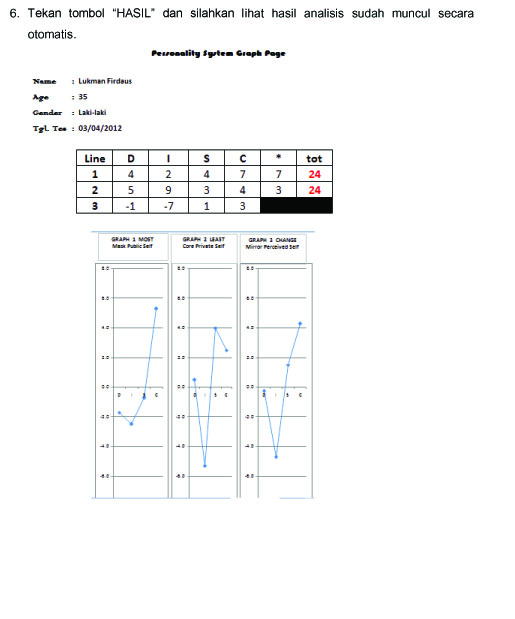Oil Formation Volume Factor Formula. Where bo= oil formation volume factor, bbl/stb, (vo)p,t= volume of oil under pressure p and temperature t, and (vo)sc= volume of oil is at standard conditions [5]. Reserve = v φ s 0 b 0 × recovery factor here, v is reservoir volume, φ is average porosity, s 0 is the average oil saturation, and b 0 is oil formation volume factor. B o is the oil phase formation volume factor at p r and t r, bbl/stb; Total formation volume factor, bt bt bo bg rsb rs above pb, bt = bo 13.
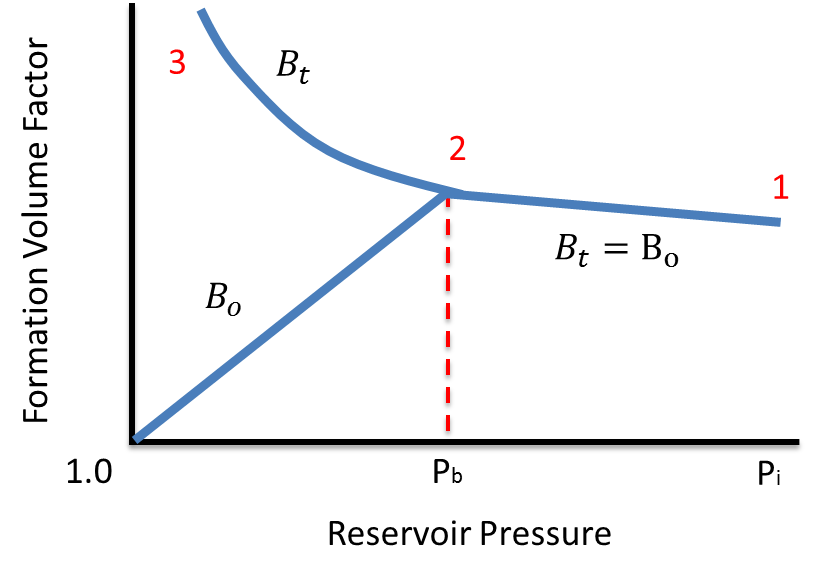 Two Phase Oil Formation Volume Factor (Bt) Top Dog Engineer From topdogengineer.com
Two Phase Oil Formation Volume Factor (Bt) Top Dog Engineer From topdogengineer.com
Gamma_g = gas gravity (air=1.0), [0.59,0.95] tr = reservoir temperature, f, [100,258] and. Dindoruk and christman correlation for oil formation volume factor, p = pb, [bbl/stb] Standing initially produced a graphical correlation for estimating the oil formation volume factor, and later expressed the graph by the following correlation: It has since been shown that f is independent of r w only for a certain class of petrophysically simple. M g = gas molecular weight, m, lbm/lbm mol m go = gas/oil mixture molecular weight, m, lbm/lbm mol m o = Total formation volume factor, bt bt bo bg rsb rs above pb, bt = bo 13.
Each data set contains reservoir temperature, oil gravity, total solution gas oil ratio, average gas gravity, and oil formation volume factor.
That is, (2.6) b o = v r e s v s t , Total formation volume factor, bt bt bo bg rsb rs above pb, bt = bo 13. Gor = r s + [k rg / kro] [μ o b o / μgbg] gor = 11 + [12/16] [7 x 18 /9 x 22] gor = 11 + [12/16] [126/198] gor = 11 + [12/16] [0.63] gor = 11 + [0.75] [0.63] gor = 11 + 0.477 gor = 11.477. K ro = relative permeability to oil = 16 b g = gas formation volume factor = 22 b o = oil formation volume factor = 18. Gamma_g = gas gravity (air=1.0), [0.59,0.95] tr = reservoir temperature, f, [100,258] and. = stock tank oil density, kg/m 3.
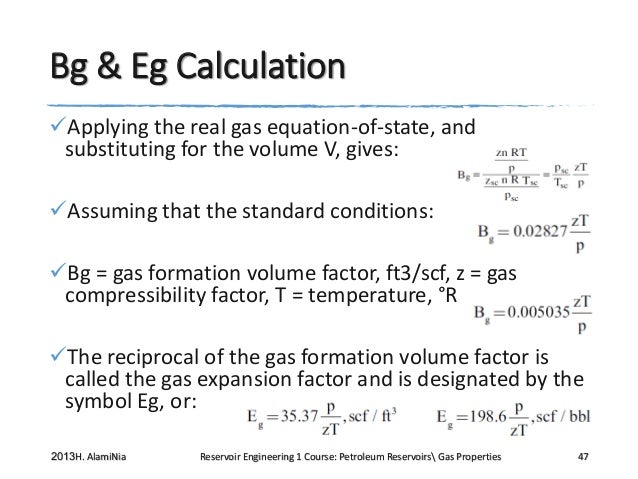 Source: es.slideshare.net
Source: es.slideshare.net
The formation volume factor of an oil or condensate (b o) relates the volume of 1 lbmol of liquid at reservoir conditions to the volume of that liquid once it has gone through the surface separation facility. • oil formation volume factor reflects these changes • more fundamentally in the coefficient of compressibility of the oil. Reserve = v φ s 0 b 0 × recovery factor here, v is reservoir volume, φ is average porosity, s 0 is the average oil saturation, and b 0 is oil formation volume factor. Total formation volume factor, bt bt bo bg rsb rs above pb, bt = bo 13. = oil specific gravity, dimensionless.
 Source: youtube.com
Source: youtube.com
It has since been shown that f is independent of r w only for a certain class of petrophysically simple. Oil compressibility • volume changes of oil above the bubble point are very significant in recovering undersaturated oil. Bo= oil formation volume factor, bbl/stb. [formation evaluation] the ratio of the resistivity of a rock filled with water (r o) to the resistivity of that water (r w).g.e. K ro = relative permeability to oil = 16 b g = gas formation volume factor = 22 b o = oil formation volume factor = 18.
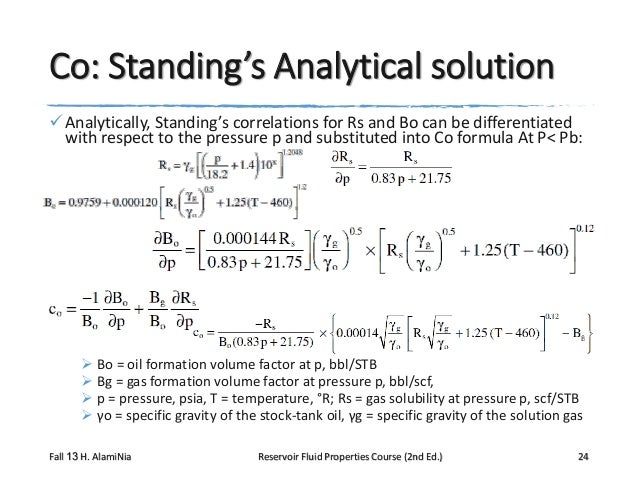 Source: slideshare.net
Source: slideshare.net
Archie postulated that the formation factor (f) was a constant independent of r w and solely a function of pore geometry (the archie equation i). Gamma_g = gas gravity (air=1.0), [0.59,0.95] tr = reservoir temperature, f, [100,258] and. Where bo= oil formation volume factor, bbl/stb, (vo)p,t= volume of oil under pressure p and temperature t, and (vo)sc= volume of oil is at standard conditions [5]. Each data set contains reservoir temperature, oil gravity, total solution gas oil ratio, average gas gravity, and oil formation volume factor. Reserve = v φ s 0 b 0 × recovery factor here, v is reservoir volume, φ is average porosity, s 0 is the average oil saturation, and b 0 is oil formation volume factor.
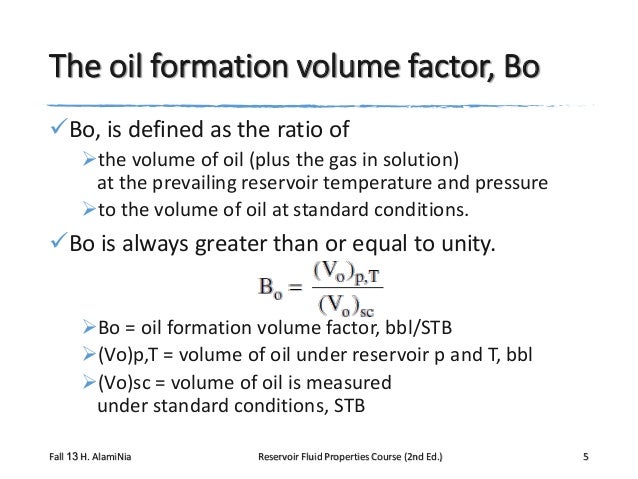 Source: slideshare.net
Source: slideshare.net
Reserve = v φ s 0 b 0 × recovery factor here, v is reservoir volume, φ is average porosity, s 0 is the average oil saturation, and b 0 is oil formation volume factor. = oil specific gravity, dimensionless. • oil formation volume factor reflects these changes • more fundamentally in the coefficient of compressibility of the oil. The formula for calculating the total fvf: K ro = relative permeability to oil = 16 b g = gas formation volume factor = 22 b o = oil formation volume factor = 18.

B t = total fvf The formation volume factor of an oil or condensate (b o) relates the volume of 1 lbmol of liquid at reservoir conditions to the volume of that liquid once it has gone through the surface separation facility. That is, (2.6) b o = v r e s v s t , K w = watson characterization factor, °r 1/3: (vo)p, t= volume of oil under reservoir pressure, p, and temperature, i, bbl.
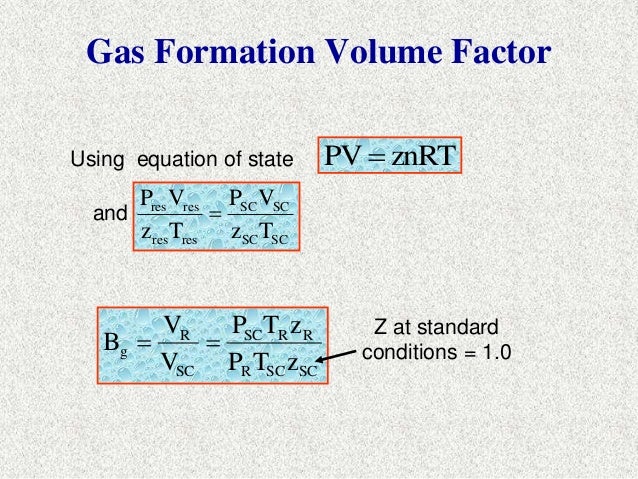 Source: slideshare.net
Source: slideshare.net
• oil formation volume factor reflects these changes • more fundamentally in the coefficient of compressibility of the oil. (vo)p, t= volume of oil under reservoir pressure, p, and temperature, i, bbl. The formula for calculating the total fvf: = oil density at reservoir conditions, kg/m 3. Standing initially produced a graphical correlation for estimating the oil formation volume factor, and later expressed the graph by the following correlation:
 Source: researchgate.net
Source: researchgate.net
Bo= oil formation volume factor, bbl/stb. This correlation was made from the differential liberation curves of 159 analyses of saturated eastern venezuelan crudes. K w = watson characterization factor, °r 1/3: Reserve = v φ s 0 b 0 × recovery factor here, v is reservoir volume, φ is average porosity, s 0 is the average oil saturation, and b 0 is oil formation volume factor. Each data set contains reservoir temperature, oil gravity, total solution gas oil ratio, average gas gravity, and oil formation volume factor.
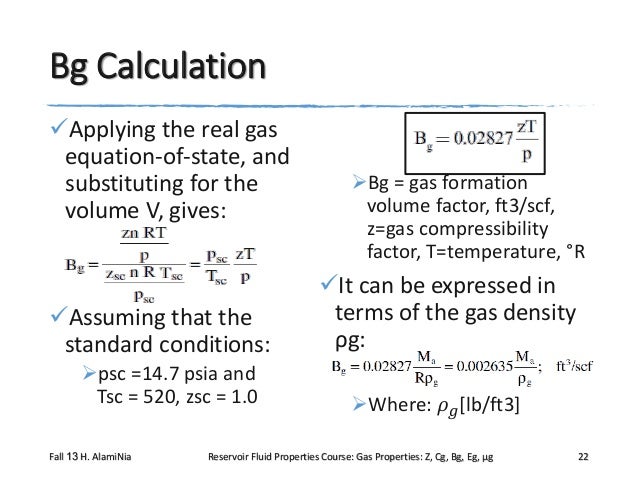 Source: slideshare.net
Source: slideshare.net
That in this work a universal ann model for oil fvf is sought for while that of[15] is for different api classes. Bo = oil formation volume factor, bbl/stb, rs = solution gor, scf/stb, [20,1425]. Gamma_g = gas gravity (air=1.0), [0.59,0.95] tr = reservoir temperature, f, [100,258] and. = stock tank oil density, kg/m 3. M g = gas molecular weight, m, lbm/lbm mol m go = gas/oil mixture molecular weight, m, lbm/lbm mol m o =
 Source: topcargmain.blogspot.com
Source: topcargmain.blogspot.com
It has since been shown that f is independent of r w only for a certain class of petrophysically simple. F = rs*(gamma_g/gamma_o)**0.5 + 1.25*t. For more info, refer tovasquez & beggs(best),lasater(better), orstanding(good). “ formation volume factor of oil” is defined as the volume occupied in the reservoir at the prevailing pressure and temperature by volume of oil in stock tank, plus its dissolved gas; [formation evaluation] the ratio of the resistivity of a rock filled with water (r o) to the resistivity of that water (r w).g.e.
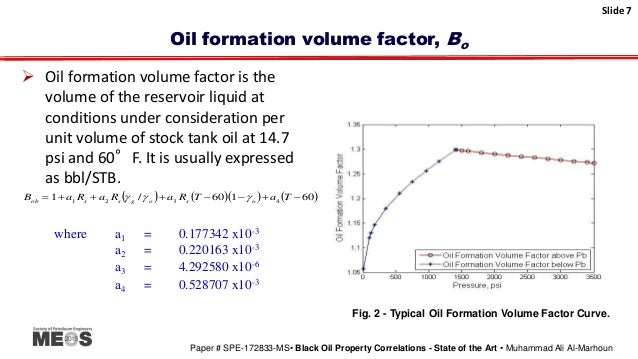 Source: slideshare.net
Source: slideshare.net
Where bo= oil formation volume factor, bbl/stb, (vo)p,t= volume of oil under pressure p and temperature t, and (vo)sc= volume of oil is at standard conditions [5]. B t = total fvf = oil formation volume factor, rm 3 /sm 3. Note that here porosity and saturation are estimated (using different sources of information such as well logging, well tests, and seismic data) and have their own uncertainties. (vo)sc= volume of oil is measured under standard conditions, stb.
 Source: researchgate.net
Source: researchgate.net
(vo)sc= volume of oil is measured under standard conditions, stb. K w = watson characterization factor, °r 1/3: = oil formation volume factor, rm 3 /sm 3. That is, (2.6) b o = v r e s v s t , K ro = relative permeability to oil = 16 b g = gas formation volume factor = 22 b o = oil formation volume factor = 18.
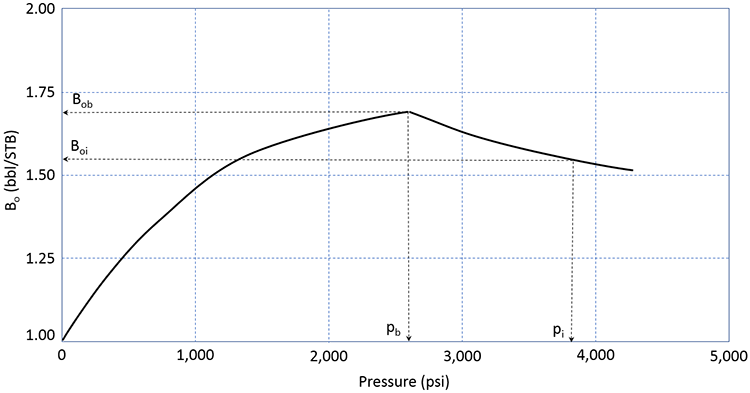 Source: e-education.psu.edu
Source: e-education.psu.edu
B t = total fvf = oil formation volume factor, rm 3 /sm 3. “ formation volume factor of oil” is defined as the volume occupied in the reservoir at the prevailing pressure and temperature by volume of oil in stock tank, plus its dissolved gas; Bo = oil formation volume factor, bbl/stb, rs = solution gor, scf/stb, [20,1425]. Dindoruk and christman correlation for oil formation volume factor, p = pb, [bbl/stb]
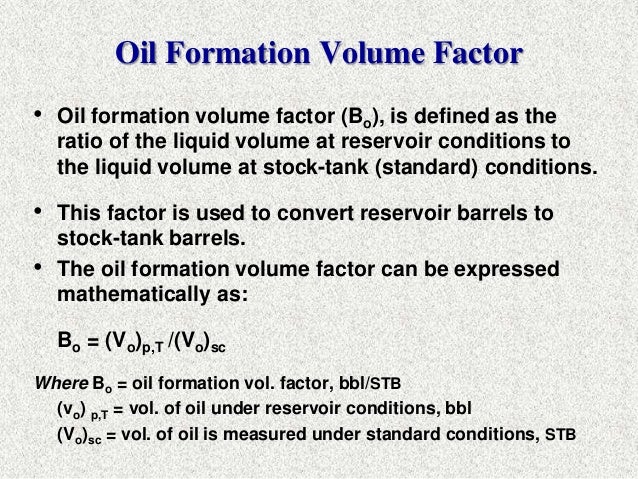 Source: slideshare.net
Source: slideshare.net
B o is the oil phase formation volume factor at p r and t r, bbl/stb; Volume occupied by initial oil in place = n boi where n = oil initially in place, stb boi = oil formation volume factor at initial reservoir pressure pi, bbl/stb. B o is the oil phase formation volume factor at p r and t r, bbl/stb; To compute for the total fvf, four essential parameters are needed and these parameters are oil fvf (b o), gas fvf (b g), initial gas solubility (r si) and current gas solubility (r s). Oil compressibility • volume changes of oil above the bubble point are very significant in recovering undersaturated oil.
 Source: topdogengineer.com
Source: topdogengineer.com
Each data set contains reservoir temperature, oil gravity, total solution gas oil ratio, average gas gravity, and oil formation volume factor. Standing initially produced a graphical correlation for estimating the oil formation volume factor, and later expressed the graph by the following correlation: Total formation volume factor, bt bt bo bg rsb rs above pb, bt = bo 13. The viscosity of a crude oil is also impacted by the amount of gas in solution. M g = gas molecular weight, m, lbm/lbm mol m go = gas/oil mixture molecular weight, m, lbm/lbm mol m o =
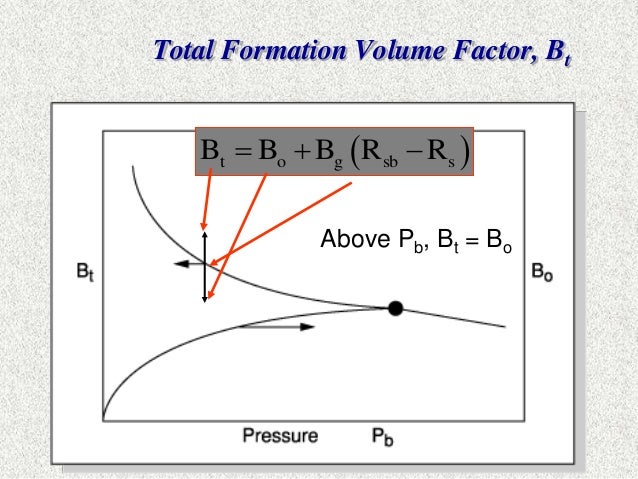 Source: pt.slideshare.net
Source: pt.slideshare.net
Since most measurements of oil and gas production are made at the surface, and since the fluid flow takes place in the formation, volume factors are needed to convert measured surface volumes to. B o is the oil phase formation volume factor at p r and t r, bbl/stb; Volume occupied by initial oil in place = n boi where n = oil initially in place, stb boi = oil formation volume factor at initial reservoir pressure pi, bbl/stb. That in this work a universal ann model for oil fvf is sought for while that of[15] is for different api classes. That is, (2.6) b o = v r e s v s t ,
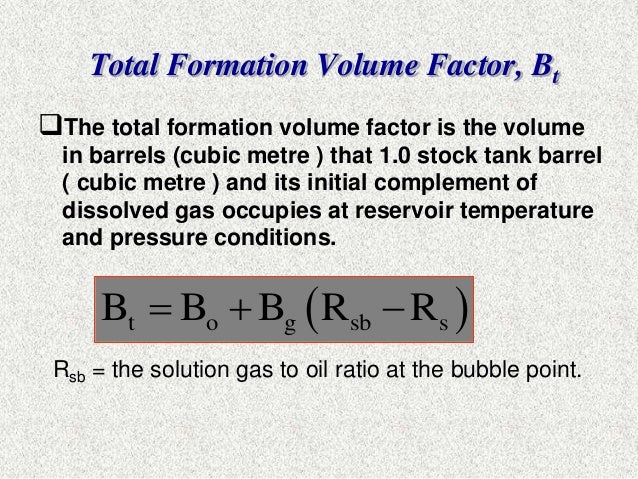 Source: slideshare.net
Source: slideshare.net
It has since been shown that f is independent of r w only for a certain class of petrophysically simple. • oil formation volume factor reflects these changes • more fundamentally in the coefficient of compressibility of the oil. [formation evaluation] the ratio of the resistivity of a rock filled with water (r o) to the resistivity of that water (r w).g.e. = oil formation volume factor, rm 3 /sm 3. Since most measurements of oil and gas production are made at the surface, and since the fluid flow takes place in the formation, volume factors are needed to convert measured surface volumes to.
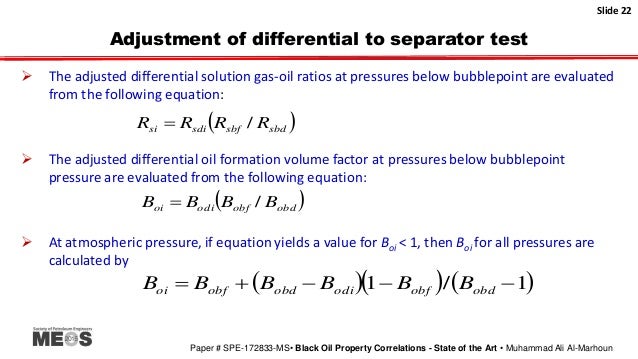 Source: slideshare.net
Source: slideshare.net
The formation volume factor of an oil or condensate (b o) relates the volume of 1 lbmol of liquid at reservoir conditions to the volume of that liquid once it has gone through the surface separation facility. Note that here porosity and saturation are estimated (using different sources of information such as well logging, well tests, and seismic data) and have their own uncertainties. This correlation was made from the differential liberation curves of 159 analyses of saturated eastern venezuelan crudes. B t = total fvf K ro = relative permeability to oil = 16 b g = gas formation volume factor = 22 b o = oil formation volume factor = 18.
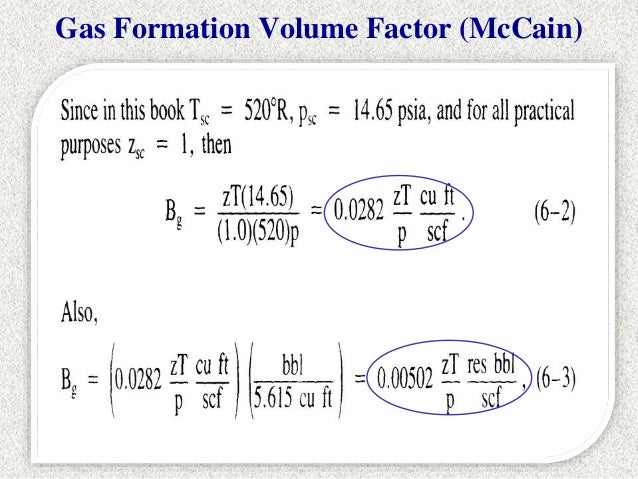 Source: slideshare.net
Source: slideshare.net
Oil compressibility • volume changes of oil above the bubble point are very significant in recovering undersaturated oil. The formation volume factor of an oil or condensate (b o) relates the volume of 1 lbmol of liquid at reservoir conditions to the volume of that liquid once it has gone through the surface separation facility. It has since been shown that f is independent of r w only for a certain class of petrophysically simple. K w = watson characterization factor, °r 1/3: Where bo= oil formation volume factor, bbl/stb, (vo)p,t= volume of oil under pressure p and temperature t, and (vo)sc= volume of oil is at standard conditions [5].
This site is an open community for users to do sharing their favorite wallpapers on the internet, all images or pictures in this website are for personal wallpaper use only, it is stricly prohibited to use this wallpaper for commercial purposes, if you are the author and find this image is shared without your permission, please kindly raise a DMCA report to Us.
If you find this site good, please support us by sharing this posts to your own social media accounts like Facebook, Instagram and so on or you can also save this blog page with the title oil formation volume factor formula by using Ctrl + D for devices a laptop with a Windows operating system or Command + D for laptops with an Apple operating system. If you use a smartphone, you can also use the drawer menu of the browser you are using. Whether it’s a Windows, Mac, iOS or Android operating system, you will still be able to bookmark this website.





